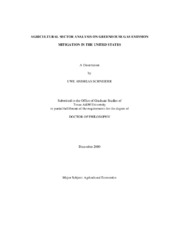| dc.description.abstract | This dissertation analyzes the economic potential of agriculture to participate in
greenhouse gas emission mitigation efforts. Major agricultural mitigation strategies are
included simultaneously to capture interactions. Results indicate that agriculture's
contribution to emission reduction may be substantial, but not sufficient to fulfill the
requirements of the Kyoto Protocol, which are estimated to be in the neighborhood of
700 million metric tons (MMT) of carbon equivalents by the year 2010. Even under
extreme economic incentives, the annual emission reduction potential from U.S.
agriculture does not exceed 300 MMT if including all carbon dioxide related strategies,
or 400 MMT if also including carbon equivalent emission reductions of methane and
nitrous oxide related strategies.
Production of biomass feedstock for power plants, i.e. switch grass, becomes the
dominating mitigation strategy for carbon saving incentives of $80 per ton of carbon
equivalent and above. Lower incentives between $5 and $80 per metric ton of carbon
equivalent lead to a complex mixture of various mitigation strategies involving reduced
iv
fertilization, tillage, and irrigation; increased afforestation; and improved liquid manure
management. In addition to net emission reductions between 25 and 70 MMT of carbon
equivalents, low carbon incentives involve substantial environmental gains through less
erosion and less nitrogen pollution.
Empirical results from this dissertation show the importance of accounting for
interdependencies among mitigation strategies. The savings potential of mitigation
strategies examined individually may be considerably higher than it is under a joint
analysis. The findings also provide support for a new breed of combined environmental
and farm policy, which would replace costly individual programs aimed at various
environmental goals or to provide for fair farm incomes. | en |



